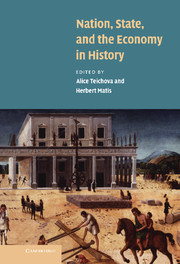Book contents
- Frontmatter
- Contents
- List of figures
- List of tables
- List of contributors
- Acknowledgements
- Introduction
- PART I
- PART II
- 7 The state and economic development in Central and Eastern Europe
- 8 Concepts of economic integration in Austria during the twentieth century
- 9 The economy and the rise and fall of a small multinational state: Czechoslovakia, 1918–1992
- 10 Economic retardation, peasant farming and the nation-state in the Balkans: Serbia, 1815–1912 and 1991–1999
- 11 National and non-national dimensions of economic development in nineteenth- and twentieth-century Russia
- PART III
- PART IV
- PART V
- Index
9 - The economy and the rise and fall of a small multinational state: Czechoslovakia, 1918–1992
Published online by Cambridge University Press: 07 September 2009
- Frontmatter
- Contents
- List of figures
- List of tables
- List of contributors
- Acknowledgements
- Introduction
- PART I
- PART II
- 7 The state and economic development in Central and Eastern Europe
- 8 Concepts of economic integration in Austria during the twentieth century
- 9 The economy and the rise and fall of a small multinational state: Czechoslovakia, 1918–1992
- 10 Economic retardation, peasant farming and the nation-state in the Balkans: Serbia, 1815–1912 and 1991–1999
- 11 National and non-national dimensions of economic development in nineteenth- and twentieth-century Russia
- PART III
- PART IV
- PART V
- Index
Summary
The Czechoslovak Republic was founded on 28 October 1918 as one of the successor states to Austria-Hungary, and comprised the Czech Lands, Slovakia and the easternmost Subcarpathian Ruthenia annexed in 1919. From the Habsburg monarchy Czechoslovakia inherited 21 per cent of the territory and 25 per cent of the population. After stabilising its frontiers the new state had a population of 13.5 million.
Over the seventy-four years of its existence (until its division into two republics on 1 January 1993) Czechoslovakia went through far-reaching economic and social changes and experienced considerable shifts in the nationality structure of its population. The multinational pattern of the population, typical of the inter-war period, was simplified in the course of the Second World War and soon after the end of that war owing to the tragic fate of the Jewish population, the annexation of Subcarpathian Ruthenia to the Soviet Union, the expulsion of Germans, the exchange of the population with Hungary, and the return of emigrated Czechs and Slovaks from various countries of the world. According to the 1930 census, 66 per cent of the population (9,689,000) were Czechs and Slovaks; by 1948 that percentage had risen to 95 per cent (11,584,000) and did not undergo any more substantial changes over the following decades.
The Czech Lands, a part of Cisleithania in Austria-Hungary, enjoyed a considerably higher economic and cultural standard than Slovakia, which had been part of Hungary (Transleithania).
- Type
- Chapter
- Information
- Nation, State and the Economy in History , pp. 181 - 196Publisher: Cambridge University PressPrint publication year: 2003



